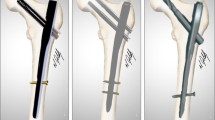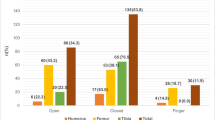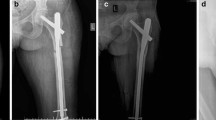Abstract
Introduction
This level II prospective study investigates patient and fracture-related factors likely to affect closed reduction time in the surgical treatment of femur fractures, and the effect these factors have on closed reduction time.
Patients and methods
Seventy-nine diaphyseal femur fractures of 75 patients were included in the present study. All fractures were treated with indirect closed reduction by manual traction using antegrade nailing and static, locked, reamed intramedullary nails. The three variables considered to influence the duration of closed reduction, that is, the type of fracture, BMI, and the preoperative period (time from injury to surgery), were evaluated either separately or in a combination of two or three of the variables. Their influence on the closed reduction time was analyzed and evaluated.
Results
In this study according to the outcomes, a preoperative period ≤24 h had a significant effect in shortening the reduction time. The reduction time was not significantly affected by the type of fracture. The reduction time was prolonged in overweight patients, but the difference was not significant. When the three variables BMI, preoperative period, and fracture types were evaluated together, the common effect of these three variables was not significant.
Conclusion
In conclusion, based on these results, we think that closed reduction should certainly be aimed for in femur fractures in which intramedullary nailing is planned. Also, early surgical intervention appears to have a beneficial effect on the success of closed reduction.
Similar content being viewed by others
References
Bone LB, Johnson KD, Weigelt J, Scheinberg R (1989) Early versus delayed stabilization of femoral fractures. A prospective randomized study. J Bone Joint Surg Am 71:336–340
Winquist RA (1993) Locked femoral nailing. J Am Acad Orthop Surg 1:95–105
Brumback RJ, Uwagie-Ero S, Lakatos RP, Poka A, Bathon GH, Burgess AR (1988) The rationales of interlocking nailing of the femur, tibia, and humerus. J Bone Joint Surg Am 70:1453–1462
Wolinsky PR, McCarty E, Shyr Y, Johnson K (1999) Reamed intramedullary nailing of the femur: 551 cases. J Trauma 3:392–399
Harper MC (1985) Fractures of the femur treated by open and closed intramedullary nailing using the fluted rod. J Bone Joint Surg Am 67:699–708
Winquist RA, Hansen ST Jr, Clawson DK (1984) Closed intramedullary nailing of femoral fractures. A report of five hundred and twenty cases. J Bone Joint Surg Am 66:529–539
Tornetta P 3rd, Tiburzi D (2000) Antegrade or retrograde reamed femoral nailing. A prospective, randomised trial. J Bone Joint Surg Br 82:652–654
Aiyer S, Jaqiasi J, Aregekar H, Sharan S, Dasgupta P (2006) Closed antegrade interlocked nailing of femoral shaft fractures operated up to 2 weeks postinjury in the absence of a fracture table or C-arm. J Trauma 61:457–460
Rhorer AS (2009) Percutaneous/minimally invasive techniques in treatment of femoral shaft fractures with an intramedullary nail. J Orthop Trauma 23:S2–S5
Benirschke SK, Melder I, Henley MB, Routt ML, Smith DG, Charpman JR, Swiontkowski MF (1993) Closed interlocking nailing of femoral shaft fractures: assessment of technical complications and functional outcomes by comparison of a prospective database with retrospective review. J Orthop Trauma 7:118–122
Helmy N, Jando VT, Lu T, Chan H, O’Brien PJ (2008) Muscle function and functional outcome following standard antegrade reamed intramedullary nailing of isolated femoral shaft fractures. J Orthop Trauma 22:10–15
Paterno MV, Archdeacon MT (2009) Is there a standard rehabilitation protocol after femoral intramedullary nailing? J Orthop Trauma 23:S39–S46
Thoresen BO, Alho A, Ekeland A, Strømsøe K, Follerås G, Haukebø A (1985) Interlocking intramedullary nailing in femoral shaft fractures. A report of forty-eight cases. J Bone Joint Surg (Am) 67:1313–1320
Crist BD, Wolinsky PR (2009) Reaming does not add significant time to intramedullary nailing of diaphyseal fractures of the tibia and femur. J Trauma 67:727–734
Rudloff MI, Smith WR (2009) Intramedullary nailing of the femur: current concepts concerning reaming. J Orthop Trauma 23:S12–S17
Alho A, Strømsøe K, Ekeland A (1991) Locked intramedullary nailing of femoral shaft fractures. J Trauma 31:49–59
Tuttle MS, Smith WR, Williams AE, Aqudelo CF, Hartshorn CJ, Moore EE, Morgan SJ (2009) Safety and efficacy of damage control external fixation versus early definitive stabilization for femoral shaft fractures in the multiple-injured patient. J Trauma 67:602–605
Tucker MC, Schwappach JR, Leighton RK, Coupe K, Ricci WM (2007) Results of femoral intramedullary nailing in patients who are obese versus those who are not obese: a prospective multicenter comparison study. J Orthop Trauma 21:523–529
Clinical Guidelines on the Identification, Evaluation, and Treatment of Overweight and Obesity in Adults (1998) The evidence report. National Institutes of Health. Obes Res 6:51 S–209 S
O’Toole RV, O’Brien M, Scalea MT, Habashi N, Pollak AN, Turen CH (2009) The treatment of femoral shaft fractures by closed Küntscher nailing (without reaming). J Trauma 67:1013–1021
Liao JC, Hsieh PH, Chuang TY, Su JY, Chen CH, Chen YJ (2003) Mini-open intramedullary nailing of acute femoral shaft fracture: reduction through a small incision without a fracture table. Chang Gung Med J 26:660–668
Ong LB, Satku K, Lim PH (1981) The treatment of femoral shaft fractures by closed Küntscher nailing (without reaming). Injury 12:466–470
Brumback RJ (1996) The rationales of interlocking nailing of the femur, tibia, and humerus. Clin Orthop Relat Res 324:292–320
Conflict of interest
The authors warrant that they do not have any financial and personal relationships with other people, or organisations, that could inappropriately influence (bias) this work, all within 3 years of the beginning the work submitted.
Author information
Authors and Affiliations
Corresponding author
Rights and permissions
About this article
Cite this article
Yildirim, A.O., Oken, O.F., Katı, Y.A. et al. Factors affecting the closed reduction of diaphyseal fractures of the femur. Eur J Orthop Surg Traumatol 23, 945–951 (2013). https://doi.org/10.1007/s00590-012-1107-8
Received:
Accepted:
Published:
Issue Date:
DOI: https://doi.org/10.1007/s00590-012-1107-8




